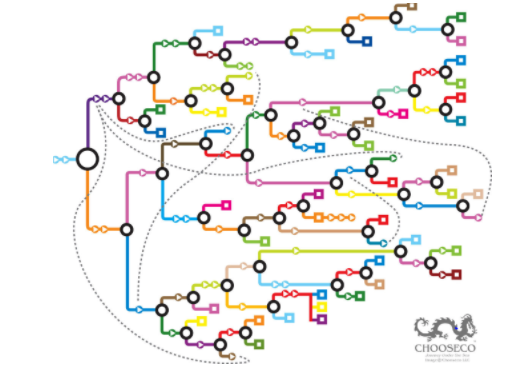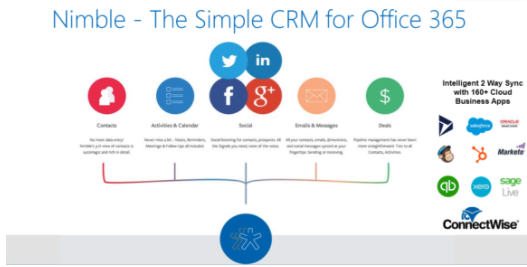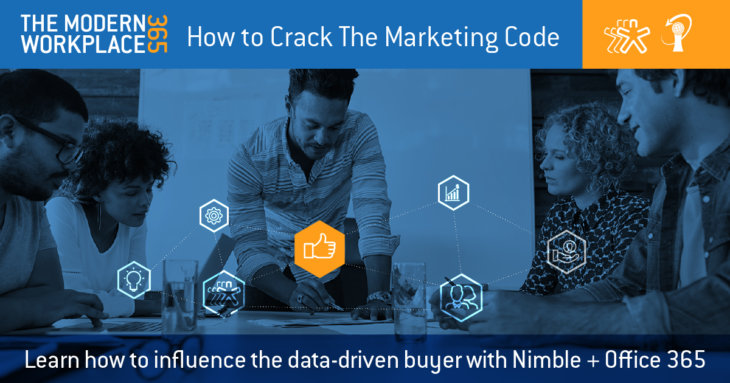The Modern Workplace 365 is a five-part series on the evolution in the way customers buy and how Modern Sellers need to shift to stay relevant. This Modern Workplace series was commissioned by Nimble and the International Association for Microsoft Channel Partners (IAMCP).
It’s designed to help small business teams and workgroups understand the data-driven buyer’s journey, leverage new technology that maximizes the customer experience and empower customer-facing teams that are part of today’s Modern Workplace.
In this post, we’ll discuss shifts in the digital buyer’s mindset, factors influencing their buying decision, and strategies that enable marketing teams to influence the buyer’s journey.
The rise of the data-driven buyer
Ten years ago, digital marketing barely existed.
Business to business (B2B) sales and marketing consisted primarily of blasting company accolades and award-winning features across the web.
In the race to deliver marketing qualified leads (MQLs), the needs of prospective buyers were often overlooked.
As millions of businesses broadcast their wares across the internet, social platforms, email, and mobile channels, the noise level can be deafening.

Buyers have vehemently turned away from brand-driven content in favor of a self-service modality. One one hand, buyers expect instant access to the company, product, pricing, and service information. They want clear guidance on usage, readily available support, reviews, competitive comparisons, and articles to help evaluate their options. They choose where, when, and how to interact with your sales and marketing teams.
On the other hand, buyers expect company representatives to understand their questions and concerns; know what they’ve previously bought, and respond personally to their inquiries in a matter of hours or minutes, and not days.
The Modern Workplace, therefore, needs to encapsulate customer data and communications — including all prior email, social and chats with every employee — into a single, easily accessible system of record. Next steps directed to sales teams need to be assigned easily and automated wherever possible. Finally, customer-facing teams need to be able to easily collaborate within a secure, scalable environment.
Cost is another key consideration, especially since most small and mid-sized organizations do not have unlimited IT budgets and staff resources.
Fortunately, Microsoft, Cloud Solution Providers, and third-party ISVs like Nimble are working closely together to deliver right-sized, ROI-positive solutions to marketing organizations’ overarching business challenges.
How to crack the digital marketing code
Digital marketing expert, best selling author, and keynote speaker Bryan Kramer likens the modern buyer’s journey to a “choose your own adventure game, with hundreds of ways people can see, hear, feel or touch a product or service, company or brand.”

In this online adventure game, the customer is undoubtedly in control. Console at hand, they’re charting their own course.
In the race to adapt, savvy marketers are going toe-to-toe with the world’s biggest and best by optimizing every touch point, automating processes wherever possible while still maintaining a human connection with their audience, and driving engagement.
Internet marketing powerhouse Jeff Bullas recommends a six-step framework to generate MQLs at scale and increase buyer engagement at a reasonable ROI. Jeff advises his community of 25 million blog readers to:
- Create great content that solves the clients biggest problems and challenges. “Marketing is about solving people’s problems. Give them a tip about a solution to their pains, and they will keep turning up to find out more. Use words, images, and videos that they can easily understand and are easy to find in the places they frequent — whether that be online or offline.“
- Drive traffic to that content either via email, social, search engines or paid social media ads. “Guest blogging, social media posts, on-page SEO, targeting long-tail keywords… there are so many ways to drive traffic to your content. The great thing is many are low-cost or free.”
- Convert that traffic into email subscribers or even Facebook messenger subscribers. “If you’re not capturing the emails of visitors reaching your website, you’re missing out on huge potential growth. Engaged email list subscribers are the biggest asset for any blog or online business. They’re your qualified sales leads. It’s much easier to build relationships, generate returning traffic, and make repeat sales to your list of subscribers as compared to normal visitors.”
- Build your email subscriber list. “We live in a freemium economy. To build your email list, offer subscribers something of value when they sign up. Start solving your prospective buyer’s problems and you’ll start building credibility and trust.”
- Nurture those subscribers. “To move the prospects from your lead generation efforts to customers, you need to nurture them. Use a multi-channel approach to connect with prospects more often, develop targeted content that answers their questions, personalize your correspondence, and use timely follow-ups to close sales.”
- Convert that attention and trust into leads and sales with automated sales funnels. “According to ReachMail, an average of 60% of subscribers to an email list are inactive. That’s a lot of untapped potential. Build email automation funnels to trigger email sends when a particular action or series of actions occur, such as when a subscriber joins or leaves your list, or when a visitor requests a piece of content.”
Because buyers are overloaded with email, social, and web outreach every day, Jeff optimizes every part of the sales journey as much as possible — from initial traffic to landing pages to clicks and conversions.
 “The marketing funnel varies so much that there is no perfect formula. It starts with awareness, then attention, and followed with conversion. If you can automate most of the funnel, then you have a predictable, scalable business model.”
“The marketing funnel varies so much that there is no perfect formula. It starts with awareness, then attention, and followed with conversion. If you can automate most of the funnel, then you have a predictable, scalable business model.”
– Jeff Bullas
Humanize. Energize. Monetize.
“Emotional connection is and always has been what motivates a buyer to make a purchase,” explains Bryan Kramer. “We buy from people — we don’t buy from companies. Bell bottoms are cool again, along with all the things we loved in the ’80s. And so is human engagement.”
Bryan contends digital marketers have gone way overboard in automation, describing the experience as downright creepy.
 “You know immediately if you’ve landed in someone’s funnel.
“You know immediately if you’ve landed in someone’s funnel.
“It’s like: ‘Here goes the next three weeks of my life being emailed all the time and retargeted online. It’s like having everything follow me everywhere!’ It feels creepy, which is the opposite of what you want.”
Instead, Bryan has built his coaching and transformation company BryanKramer.com by delivering delightful, personalized, and unexpected human moments throughout the journey. He provides a few examples:
“Try replying to all your emails by video. Address the customer by their name and give them an honest answer about whatever it is they’re emailing you about. You can even try sending them best wishes on their half birthdays.
“I doubt you’d ever get that level of personalization from most big brands. Small businesses have the advantage because they don’t have to get approval for everything. Think about those things that an enterprise can’t get out and do them.”
– Bryan Kramer
And while there’s no way to scale human engagement, Bryan believes the combination of automation and human touch delivers better outcomes.
The success of Brand 24, a social media monitoring services company, demonstrates how their surprise and delight strategy delivers the maximum effect:
 “We developed a ‘What-Happens-When-You-Subscribe-to Brand 24’ video featuring Brand 24 employees, which we personalize for every new customer. We use Nimble to build their social footprint, identify which social media channels they use the most, ask them to share the video accordingly, which people are quite eager to do.
“We developed a ‘What-Happens-When-You-Subscribe-to Brand 24’ video featuring Brand 24 employees, which we personalize for every new customer. We use Nimble to build their social footprint, identify which social media channels they use the most, ask them to share the video accordingly, which people are quite eager to do.
“We automate communications with customers and influencers as much as we possibly can, while still personalizing communications. Our steady growth and average 7 to 8.5 NPS scores demonstrate our approach is working quite well.”
-Magdalena Urbaniak, Global Communications Manager, Brand 24
Rightsizing your toolkit
One of the critical success factors in any digital transformation is rightsizing your toolset.
Historically, small businesses were unable to take advantage of digital marketing tools due to high costs and the need to individualize communications.
Companies attempted to customize enterprise solutions for workgroups of two to 25 people, only to find themselves spending thousands of dollars on CRM customization and support without achieving the results they were looking for.
 “This is no longer the case,” says Jon Rivers, CEO of Marketing Monarchs. “Digital marketing tools offering advanced segmentation capabilities have become more affordable, providing B2B companies the opportunity to tailor relevant, specific communications to every potential customer, at scale. For small teams, the ideal solution starts with a simple, affordable CRM like Nimble and builds from there.”
“This is no longer the case,” says Jon Rivers, CEO of Marketing Monarchs. “Digital marketing tools offering advanced segmentation capabilities have become more affordable, providing B2B companies the opportunity to tailor relevant, specific communications to every potential customer, at scale. For small teams, the ideal solution starts with a simple, affordable CRM like Nimble and builds from there.”
A small business CRM can unify contacts under one roof — some more intelligently than others.
With Nimble, workgroups get easy access to Office 365 or G Suite contacts, social, Microsoft Dynamics, and any number of 160+ popular SaaS business applications. Email and Twitter interactions are captured and become part of the customer record automatically. Customer records are automatically augmented with information from public social sites, expressed interests, and data pulled from a number of commercial databases.

Templated, outgoing communications are customizable to address customer’s interests and needs. Integration with desktop applications like Office 365, internal collaboration tools, and “next-step” recommendations for sales teams are also supported.
License models for cloud-based CRMs are based on usage instead of a large, up-front license fees. This model keeps initial costs low and aligns the solution investment with the business value it brings to the organization.
A solution like Nimble that is easy to implement, learn, and use reduces time to achieving a positive ROI.
Digital transformation that works
Data-driven buyers are more informed and technology-savvy than ever before and are able to engage with your company on their own through a unique customer journey path that they choose.
The challenge is the nonlinear, sporadic customer journey creates many touchpoints, conversations, notes, data, and more that you as the brand or organization need to manage.
A salesperson trying to grow a new customer must have access to information whenever they need it, wherever it resides. This creates an urgent challenge for the typical SMB organization, as we see from our conversation with Steve Slaughter of AppSmart:
“We’re working with a lot of small to medium-sized businesses that have multiple business applications, and team members typically have to look in multiple places to find contact information, business addresses, notes from previous conversations, and more. Basically, you don’t know where to find things and it slows you down.”

Lack of in-house technical support can be a challenge in any size company.
Entrepreneurs can’t afford to be distracted by technical challenges. They require solutions that are painless to implement, low maintenance, and versatile. They require leading CRM functionality. They also need a system with low IT and administrative overhead in order to focus on the task at hand: growing customers and business.
“The reality is most people aren’t on the cutting edge, and most people don’t know everything there is to know about technology,” explains Loren Feldman, Chief Content Officer at Oxford Center for Entrepreneurs.
 “It’s a real struggle if you’re trying to build a business. You’re wearing a lot of hats, you have a million things to do, and you can’t be learning all the things you need to know to stay on top of every tool that you can possibly use to build a business.”
“It’s a real struggle if you’re trying to build a business. You’re wearing a lot of hats, you have a million things to do, and you can’t be learning all the things you need to know to stay on top of every tool that you can possibly use to build a business.”
Loren advises entrepreneurs and startup teams to seek out peer-to-peer forums in order to learn what’s working for others and to get a sense of where it’s worthwhile to invest time.
Small business teams and workgroups (especially those with existing and legacy IT systems) may be better serviced by working with an experienced partner.
The right partner will have the specific technology expertise and experience needed to implement a new solution, train your staff, or integrate a legacy system or database into cloud-based solutions.
Your ideal partner understands the type of business you are in and can anticipate the challenges you are likely to run into, before they become an issue. Partners can also provide resources on an as-needed basis, reducing or eliminating the need to bring on additional IT staff on a permanent basis.
Part of the challenge for SMB companies is managing the transition to becoming a digital business, which means extending your products, services, and customer experience by integrating technology.
Your company may not think of it in those terms: most of the time a small to a mid-sized organization is looking at a specific goal; whether that is improving customer retention, growing sales and revenue, reducing costs, or improving the quality of the product experience that you provide to your customers. But at its heart, it’s a digital transformation and one that becomes especially important when it involves CRM and serving your customers.
 “When (our customers) get into the process of evaluating a digital transformation, they ask several questions about applications and solutions. But really what they’re trying to figure out is how they can achieve a business outcome. By focusing less on the solution, and more on the business outcome, we can help select the technology that fits customer needs and chart an implementation course that delivers the most time- and cost-effective outcomes.”
“When (our customers) get into the process of evaluating a digital transformation, they ask several questions about applications and solutions. But really what they’re trying to figure out is how they can achieve a business outcome. By focusing less on the solution, and more on the business outcome, we can help select the technology that fits customer needs and chart an implementation course that delivers the most time- and cost-effective outcomes.”
– Christi Keating, Christi Williams, Demand Generation Manager, Managed Solution
Closing Thoughts
Here are four key takeaway points to keep in mind as you consider how your small business or workgroup can utilize the automation and personalization required to attract data-driven buyers at scale:
1. Automation + personalization deliver the best outcomes
Automated digital marketing processes that deliver targeted, highly resonant content wherever your customers hang out online is the key to bringing leads into the sales funnel at greater volume. Personalized, highly responsive human communications are the key to closing them.
2. The technology you invest in is critical
A CRM like Nimble is a must-have for marketing teams looking to engage prospective buyers within the proper context in order to build relationships and to cultivate trust. Automating research, data entry and enrichment leaves more time for Office 365 users to influence buyers’ purchasing decision.
3. Empowered teams win games
Technology connects teams, enables greater organization, and keeps critical customer data within instant reach. It all adds up to an exceptional customer experience that ultimately grows sales and repeat customers.
4. Partners can help you determine where to invest your time and energy
Whereas peer-to-peer forums help entrepreneurs understand which technologies are working for their peers, the right Cloud Solution Providers can help you chart the course and implement the solution that works best for you.
This post was co-authored by Chris Fletcher and Jenna Dobkin.


